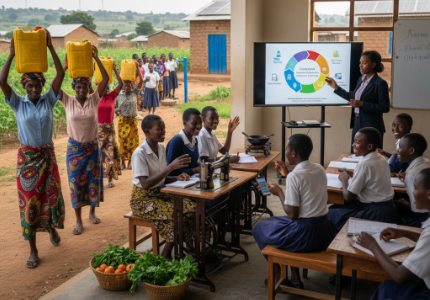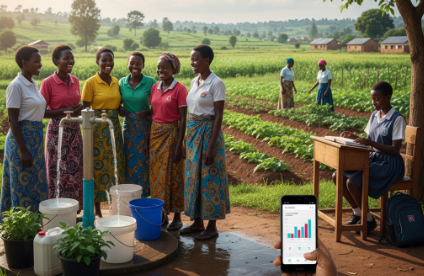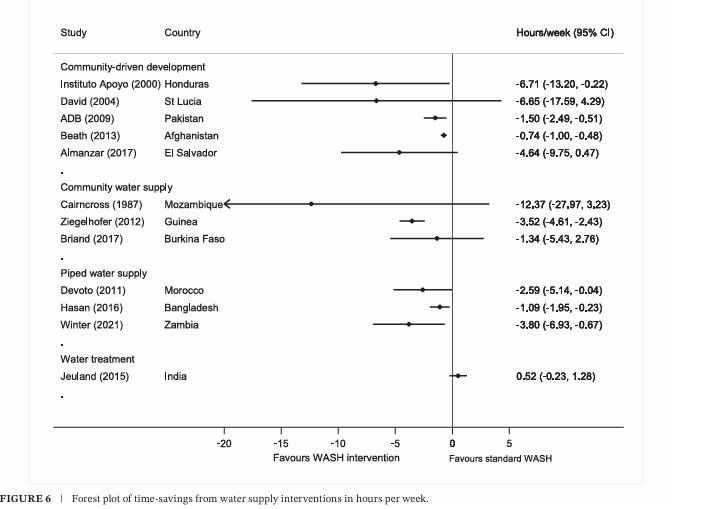

In many Kenyan households, the day begins with
the search for water.
The task often falls on women and girls who spend
hours walking to far-off sources, queuing at taps, and carrying heavy
containers back home.
This limits their opportunities for
education, work, or even rest.
For
decades, development organisations have argued that bringing water and
sanitation closer to people’s homes frees up time, especially for women and
girls.
A new international study now shows just how much
time can be reclaimed, and the difference it makes for families in Kenya and
other developing countries.
The research, No Time to Waste: A Synthesis of
Evidence on Time Reallocation Following Water, Sanitation and Hygiene
Interventions, was published in the Journal of International Development in
2025.
The research was co-authored by Hugh Sharma
Waddington, a researcher at the London School of Hygiene and Tropical
Medicine; Sarah Dickin, a researcher at Uppsala University;
and Biljana Macura, a researcher at the Stockholm Environment Institute
(SEI).
After analysing more than 30,000 records, the
authors identified 41 relevant projects across Africa, Asia, Latin America, and
the Middle East.
Taken together, the evidence shows that when clean water and sanitation are available close to home, households reclaim nearly a full working day each week.
Hours won back
On average, water supply interventions cut
collection times by 15 minutes per trip. For sanitation, the average saving was
three minutes.
Because families make multiple trips each day,
the differences add up quickly.
The study found that households gained around 8
hours per week after water supply improvements and 3.5 hours after sanitation
improvements.
In Kenya and other African countries, the effect
was striking as families saved an average of 21 minutes per trip, compared with
just 4 minutes in Asia.
In Nairobi’s settlements, installing community
standpipes reduced collection times from more than half an hour to less than
ten minutes.
In rural areas, roof catchments and new pipelines
cut journeys by up to an hour.
The scale of these benefits also varied across regions.

In sub-Saharan Africa, where nearly half the
population still relies on collecting water from outside the home, the average
time saved per trip was 21 minutes.
Elsewhere in Central and Southern Asia, where
about a quarter of people rely on collection, the savings were just 4 minutes.
In Northern Africa and Western Asia, the figure
was 12 per cent of households, while in Latin America and the Caribbean it was
only 3 per cent.
These contrasts underline how urgent the problem
remains in Africa compared with other regions.
The burden of collection falls most heavily on
women and girls. Globally, seven in ten households rely on them for the task,
compared with just over a quarter for men.
With water closer to home, women face less
physical strain and fewer safety risks, and they have more opportunities to
rest, work, or participate in community life.
“When women and girls supply part of the water
infrastructure through lengthy trips to collect water, this wastes their potential
to achieve other goals, for example regarding education and work, holding
society back,” Dickin said.
She added that the findings can help stakeholders
advocate for more investment in water and sanitation, noting that these
services are not only critical for children under five but also provide wider
societal benefits.
“Time savings mean greater dignity and people
having more time to pursue their goals,” she said.
Education benefits
One of the clearest gains is in education as the
study found medium-sized effects of water supply interventions on girls’ school
attendance, but no significant effects for boys, suggesting that girls benefit
directly when they are freed from the responsibility of water collection.
The research also found that extending municipal
piped water to households previously without it saved about an hour per trip.
Even installing community supplies in rural areas
produced similar gains during the rainy season.
The educational link is confirmed by the
data,Sharma explained that the time savings are substantial.
“We found
savings of around an hour per trip from extending municipal piped water to
households that previously lacked them, but even installing community water
supplies in rural areas saved around an hour per trip in the rainy season,” he
explained.

According to him, when water is collected daily
or even multiple times per day, the lost time quickly adds up.
“There is a strong empirical relationship between
water availability at home and girls' school attendance, partly because girls
no longer have to fetch the water,” he said.
The study concluded that when water is available
at home, girls spend more time in classrooms instead of walking to distant
points.
The ripple
effect is significant. Each lesson attended adds up over the years, shaping
futures that might otherwise have been lost to daily chores.
The report gave examples from earlier
interventions that show the scale of change possible.
In Mozambique in the 1980s, one project cut round-trip
trips from five hours to just ten minutes. In Ghana and Kenya, more recent
projects reduced trips to under an hour, while in Eswatini a community stand
post halved collection times.
In urban Kenya, the adoption of mobile billing
systems allowed people to pay for water using their phones rather than queuing
at banks, saving significant hours each week.
In parts
of Latin America, piped household connections meant that some families spent no
time at all fetching water while their neighbours without connections still
did.
Solutions that work
The study showed that not all interventions have
the same effect. Some water treatment projects or efforts to avoid contaminated
wells added a few minutes per trip.
However, larger infrastructure projects created
far greater benefits.
Piped water connections and community standpipes
produced the most significant time savings, cutting journeys dramatically
across Kenyan households.
Sharma stressed that governments should focus on
solutions that people are likely to use.
“Governments should prioritise providing what
their citizens need and are likely to use, like technology that saves drudgery,
unnecessary risk, and indignity,” he said.
“For example, having water in quantity,
preferably more than 50 litres per person and day, for personal and domestic
hygiene and drinking purposes, and also working with communities to provide
sanitation for every household.”
He added that such investments are pro-poor
growth strategies.
They free up sufficient amounts of time for
schooling or work and, according to World Bank estimates, generate millions for
the economy.
The study also pointed to Kenya’s use of mobile
billing systems for water services as an example of innovation. By enabling
families to pay through their phones, queues at water points were shortened,
saving households even more time.
In contrast, the evidence on how adults use the
time saved is less consistent across all regions and demographics, reflecting a
gap in research focus.
Policy implications
The researchers emphasised that time should be
treated as a core outcome when evaluating water and sanitation projects,
alongside health.
Macura noted that this shift is overdue.
“Policymakers and practitioners should view our
findings as a call to strengthen measurement of time use in WASH and to support
new data collection on how time savings are reallocated, including to leisure,”
she said.

The report also highlighted gaps in evidence.
Only 10 of the 41 studies broke down results by sex, and only seven included
children. Just five focused specifically on women, children or vulnerable
groups.
Two examined programmes for people with
disabilities, while none looked at pastoralist households or gender minorities.
The researchers stressed that these omissions are
serious, since time savings may be most important for these groups.
Additionally, it was noted that facilities such
as handwashing stations or menstrual waste receptacles were overlooked, even
though they are essential for health and could potentially save time.
The evidence also ties into Kenya’s development
agenda. Reducing the hours families spend collecting water directly supports
progress toward Sustainable Development Goal 6 on clean water and sanitation,
and Goal 4 on quality education.
Climate change adds another layer of urgency as
the study warned that rising temperatures and droughts could increase water
collection times by up to 30 per cent globally, and by as much as 100 per cent
in some regions.
effective interventions, women and girls will
bear the heaviest burden.
Yet challenges remain as nearly half of Kenyan
households still rely on sources outside their homes, often at a considerable
distance.
In rural areas, families still spend hours on
water collection each day.
The researchers call for governments and donors
to expand investment in piped systems and safe household toilets.
They stress that projects should be designed with
women and girls at the centre, since they bear the heaviest burden.
Time as opportunity
The hours saved ripple across households as women
who no longer spend mornings walking for water can take on other
responsibilities or simply rest.
Girls who no longer fetch water can remain in
school.
Beyond individual households, the benefits likely
spill over into communities and economies.
Time freed from collection creates the
opportunity for more hours for income-generating work, better meals prepared at
home, or participation in civic life, though further dedicated research on
adult time reallocation is still needed to quantify these broader societal
benefits.
















